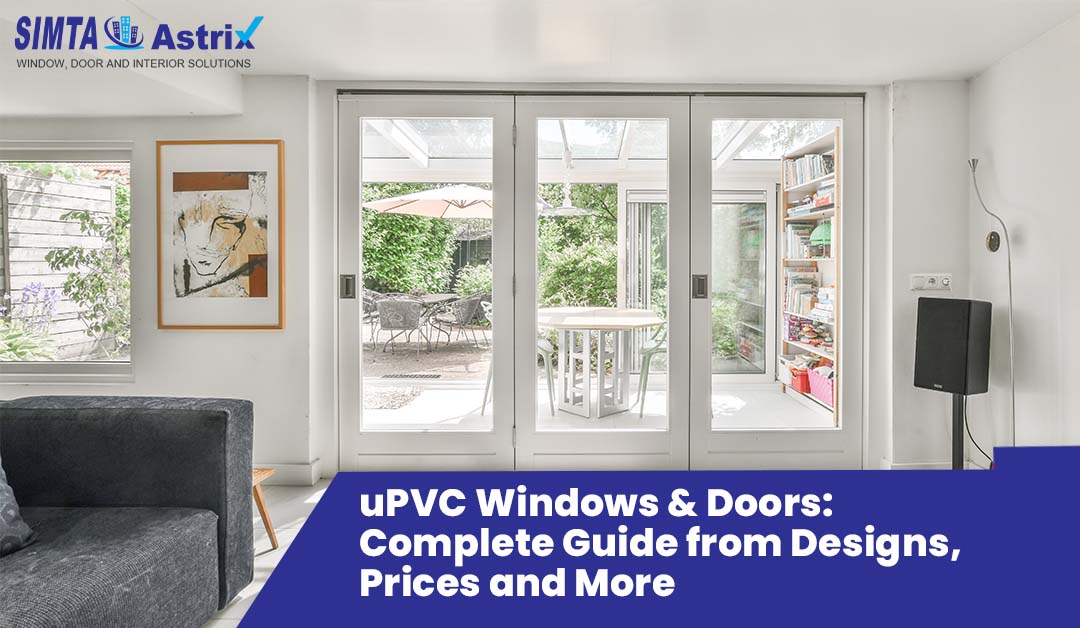What are uPVC windows and uPVC doors?
They’re frames made from unplasticized PVC with steel reinforcement, multi-chamber profiles, and compression seals.
In windows and doors, pick what serves you well over time. uPVC doors comes with steel reinforcement, multi-chamber profiles, and compression seals gives you weather resistance, energy savings, low upkeep, and a long service life. In humid and coastal cities, it holds up—it doesn’t rust, rot, or warp. Budgets typically sit around ₹500–₹900+ per sq ft installed, depending on the spec. If you want quieter rooms, go for laminated double glazing with tight seals. Compare with aluminium or wood on spans, finish, and maintenance. Always ask for UV-stabilised profiles and written test certificates.
Why you should pick uPVC Windows and Doors
The technical basics are straightforward.
- Lead-free, UV-stabilised compounds guard against yellowing and brittleness.
- Multi-chamber frames cut heat transfer and dampen noise.
- Galvanised steel keeps large openings rigid.
- Thermal-fusion welded corners, with co-extruded gaskets, stop leaks and rattles.
On glazing, choose what the room needs
- single glazing for entry budgets
- double glazing (DGU) for better thermal and acoustic control
- laminated acoustic glass with a PVB interlayer to block traffic noise and add security
- Low-E or solar-control coatings to reduce heat gain.
The idea is simple; with the right specs you get long-term value for your home, commercial space etc.
Hardware & security
- Multi-point locking spreads pressure evenly for tighter seals.
- SS 304 hardware resists corrosion in Bengaluru’s monsoon and coastal air elsewhere.
- Anti-lift rollers and child-safe restrictors add peace of mind.
Certifications & tests to ask for
- ISO standard for manufacturing systems.
- Material safety (RoHS), green credits (IGBC).
- Performance per Indian/EN standards: air/water/structural, and wind-load compliance.
- Written UV stability warranty for profiles.
Best uPVC Windows & Doors designs
uPVC Windows
- Sliding: space-saving, ideal for balconies and living rooms.
- Casement: best ventilation and sealing.
- Tilt & Turn: safe night ventilation with solid weather resistance.
- Fixed: picture views and daylight where ventilation isn’t needed.
- Bay/Arch: statement designs for facades; plan reinforcement early.
- Add-ons: integrated bug mesh, monsoon frames, ventilators.
uPVC Doors
- Sliding: smooth access to balconies and decks; easy to use.
- Casement (hinged): classic swing doors for bedrooms and kitchens.
- French: double-leaf charm with modern performance.
- Slide & Fold: wide, flexible openings for parties and airflow.
- Threshold options include low-threshold and ramp-friendly designs.
Performance of uPVC Windows and Doors
- Noise: Laminated IGU with good gaskets can reduce noise by ~35–45 dB. They are good if you stay near Metro lines, or busy junctions.
- Thermal: Multi-chambers, Low-E IGUs, and tight seals lower heat ingress, keep AC bills in check, and stop drafts.
- Weatherproofing: Welded corners, sill profiles with weep holes, and correct sealant prevent leaks during heavy rain.
Benefits of uPVC Windows and Doors that Upgrade your Home
| Factor | uPVC | Aluminium | Wood |
| Maintenance | Very low | Low-medium (finish care) | High (paint/polish) |
| Thermal | Strong | Medium (needs thermal break) | Strong |
| Acoustic | Strong with laminated IGU | Medium | Strong |
| Large spans | Medium | Excellent | Medium |
| Humid/coastal | Excellent | Good (marine grade) | Risk of warp/rot |
For everyday comfort and low upkeep, uPVC wins. For ultra-wide spans and super-slim sightlines, pick thermal-break aluminium.
Pricing & Cost Factors
Pricing varies by city, spec, and site complexity. Always compare two to three detailed quotes.
What affects price?
- Profile brand, chamber count, and reinforcement thickness.
- Glazing choice: single < double IGU < laminated acoustic IGU.
- Hardware grade, mesh systems, special finishes/laminations.
- Opening type and size (sliding often cheaper than tilt-turn).
- Retrofit vs new build, access and scaffolding needs, floor height.
Basic frame components are often quoted around ₹500-₹900 per running ft, but the installed sq-ft rate is what you should compare.
Buyer’s Checklist for uPVC Windows & Doors
UV warranty for profiles + written test certificates (air/water/structural, wind load).
Reinforcement thickness and brand of hardware stated on quote.
Warranty of 15+years
When you choose uPVC windows and doors, what you get is peace at home. That means less noise, more comfort, and very little maintenance. The right profile, proper reinforcement, and glazing will give you performance that lasts for years.
FAQs
How long do uPVC doors and uPVC windows last?
Typically 20–30 years with routine cleaning. UV-stabilised profiles and SS 304 hardware extend life in Indian climates.
Are uPVC windows truly soundproof?
They’re “sound-reducing,” not silent. With laminated double glazing and good seals, expect a substantial cut in traffic noise for bedrooms and studies.
uPVC vs aluminium: which should I choose for a wide balcony?
For very wide, heavy sashes and slim sightlines, thermal-break aluminium or lift-and-slide systems shine. For value, insulation, and low care, uPVC is hard to beat.
Do uPVC frames turn yellow?
Quality UV-stabilised frames resist discoloration. Ask for a written UV warranty and follow simple cleaning care.

